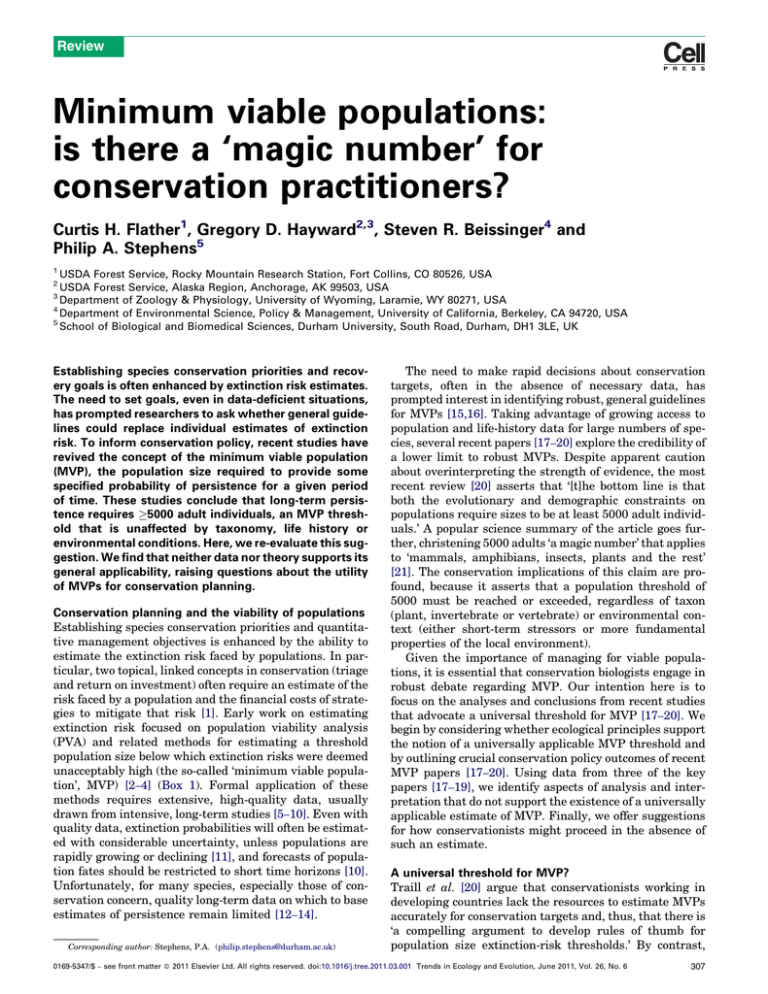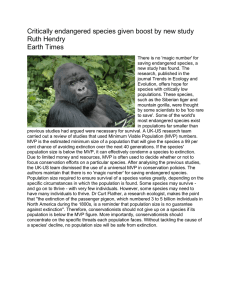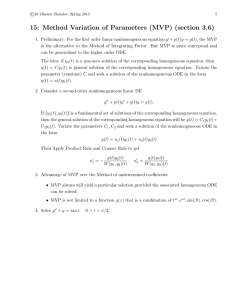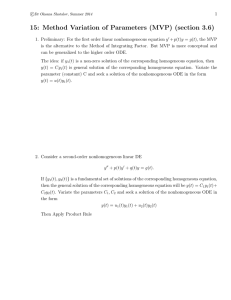
Review
Minimum viable populations:
is there a ‘magic number’ for
conservation practitioners?
Curtis H. Flather1, Gregory D. Hayward2,3, Steven R. Beissinger4 and
Philip A. Stephens5
1
USDA Forest Service, Rocky Mountain Research Station, Fort Collins, CO 80526, USA
USDA Forest Service, Alaska Region, Anchorage, AK 99503, USA
3
Department of Zoology & Physiology, University of Wyoming, Laramie, WY 80271, USA
4
Department of Environmental Science, Policy & Management, University of California, Berkeley, CA 94720, USA
5
School of Biological and Biomedical Sciences, Durham University, South Road, Durham, DH1 3LE, UK
2
Establishing species conservation priorities and recovery goals is often enhanced by extinction risk estimates.
The need to set goals, even in data-deficient situations,
has prompted researchers to ask whether general guidelines could replace individual estimates of extinction
risk. To inform conservation policy, recent studies have
revived the concept of the minimum viable population
(MVP), the population size required to provide some
specified probability of persistence for a given period
of time. These studies conclude that long-term persistence requires 5000 adult individuals, an MVP threshold that is unaffected by taxonomy, life history or
environmental conditions. Here, we re-evaluate this suggestion. We find that neither data nor theory supports its
general applicability, raising questions about the utility
of MVPs for conservation planning.
Conservation planning and the viability of populations
Establishing species conservation priorities and quantitative management objectives is enhanced by the ability to
estimate the extinction risk faced by populations. In particular, two topical, linked concepts in conservation (triage
and return on investment) often require an estimate of the
risk faced by a population and the financial costs of strategies to mitigate that risk [1]. Early work on estimating
extinction risk focused on population viability analysis
(PVA) and related methods for estimating a threshold
population size below which extinction risks were deemed
unacceptably high (the so-called ‘minimum viable population’, MVP) [2–4] (Box 1). Formal application of these
methods requires extensive, high-quality data, usually
drawn from intensive, long-term studies [5–10]. Even with
quality data, extinction probabilities will often be estimated with considerable uncertainty, unless populations are
rapidly growing or declining [11], and forecasts of population fates should be restricted to short time horizons [10].
Unfortunately, for many species, especially those of conservation concern, quality long-term data on which to base
estimates of persistence remain limited [12–14].
Corresponding author: Stephens, P.A. (philip.stephens@durham.ac.uk)
The need to make rapid decisions about conservation
targets, often in the absence of necessary data, has
prompted interest in identifying robust, general guidelines
for MVPs [15,16]. Taking advantage of growing access to
population and life-history data for large numbers of species, several recent papers [17–20] explore the credibility of
a lower limit to robust MVPs. Despite apparent caution
about overinterpreting the strength of evidence, the most
recent review [20] asserts that ‘[t]he bottom line is that
both the evolutionary and demographic constraints on
populations require sizes to be at least 5000 adult individuals.’ A popular science summary of the article goes further, christening 5000 adults ‘a magic number’ that applies
to ‘mammals, amphibians, insects, plants and the rest’
[21]. The conservation implications of this claim are profound, because it asserts that a population threshold of
5000 must be reached or exceeded, regardless of taxon
(plant, invertebrate or vertebrate) or environmental context (either short-term stressors or more fundamental
properties of the local environment).
Given the importance of managing for viable populations, it is essential that conservation biologists engage in
robust debate regarding MVP. Our intention here is to
focus on the analyses and conclusions from recent studies
that advocate a universal threshold for MVP [17–20]. We
begin by considering whether ecological principles support
the notion of a universally applicable MVP threshold and
by outlining crucial conservation policy outcomes of recent
MVP papers [17–20]. Using data from three of the key
papers [17–19], we identify aspects of analysis and interpretation that do not support the existence of a universally
applicable estimate of MVP. Finally, we offer suggestions
for how conservationists might proceed in the absence of
such an estimate.
A universal threshold for MVP?
Traill et al. [20] argue that conservationists working in
developing countries lack the resources to estimate MVPs
accurately for conservation targets and, thus, that there is
‘a compelling argument to develop rules of thumb for
population size extinction-risk thresholds.’ By contrast,
0169-5347/$ – see front matter ß 2011 Elsevier Ltd. All rights reserved. doi:10.1016/j.tree.2011.03.001 Trends in Ecology and Evolution, June 2011, Vol. 26, No. 6
307
Review
Trends in Ecology and Evolution June 2011, Vol. 26, No. 6
Box 1. History and estimation of a MVP
The MVP concept emerged in 1981 from Shaffer’s [2] pioneering
paper that defined a minimum viable population as ‘the smallest
isolated population having a 99% chance of remaining extant for
1000 years despite the foreseeable effects of demographic, environmental, and genetic stochasticity, and natural catastrophes.’ The
criteria for evaluating viability (the time frame and associated
extinction risk) were ‘tentatively and arbitrarily’ chosen by Shaffer,
recognizing that risk criteria were within the purview of society as well
as science. Operationally, time horizons of 50–100 years and extinction risk of 5% became the most frequently used criteria.
Shaffer [2] outlined five possible approaches for determining MVPs:
experiments, biogeographic patterns, theoretical models, simulation
models and genetic considerations. Experimentally manipulating the
size of replicated populations and then following their trajectories is
rarely possible in nature. Examining biogeographic patterns of
distribution can lead to estimates of minimum area requirements,
densities, or population sizes versus occupancy (i.e. incidence).
However, because of the indirect tie to extinction, this approach is
rarely used. Theoretical models can be used to predict the time
required for a population of a given size to go extinct (see [26]), but
the idiosyncratic or contextual situation that characterizes most wild
populations precludes the application of such models to real-world
conservation. Genetic considerations consisted of comparing an
estimate of the effective size (Ne) of a population to the 50/500 ‘rule’
of conservation genetics (i.e. an Ne exceeding 50 for short-term and
500 for long-term survivability). However, the 50/500 values of Ne are
simply viability goals for maintaining genetically diverse populations;
they provide little direct connection with extinction risk.
The remaining method, simulation modelling (also known as
PVA), is the most general and popular approach to estimating MVPs.
we argue that there are compelling reasons to suspect that
no single MVP is likely to apply adequately to all populations because extinction risks are often context dependent
(Box 1), and manifest from a complex interaction between
life history, environmental context and threat [22–24] that
can be difficult to detect with noisy data [5,10]. Theory
strongly suggests that the size of a population is only
marginally relevant to the extinction risk when the rate
of decline is rapid and continuous [25,26]. Characteristics
of both a ‘fast life style’ associated with small body size and
short generation times [27], and the ‘slow life style’ represented by large organisms with long generation times
[24,28] can make some species and lineages more or less
likely to go extinct, affecting any estimation of MVP.
Moreover, extinction risks differ between lineages threatened by habitat loss, lineages threatened by human persecution and introduced novel predators [22,24] and lineages
threatened by loss of food resources [29]. Thus, theory
indicates that populations of equal size will vary greatly
in their extinction risk depending on their life histories,
long-term population growth rates, habitat quality and
current threats.
The findings of recent MVP papers [17–19] are at odds
with theoretical expectations. A brief overview of the
approaches and findings used in these three recent papers
is given in Table 1. These papers have been characterized
by largely measured tones (see also [30]), with the authors
using generally careful analyses to expose sources of uncertainty in estimates of MVP. Against that backdrop, the
authors’ emergent conclusions [20] are surprising. In particular, the assertion that practitioners ‘must manage for
biologically relevant MVPs [of] at least 5000 adult individuals’ [20] is made without reference to the specifics of the
308
A stochastic population projection model is constructed from
estimates of the mean and variance of demographic rates (from
studies of individuals) or from population growth rates (i.e. r or l,
estimated from time series of counts or indices). Simulation models
project populations into the future using Monte Carlo methods,
incorporating chance events (e.g. demographic and environmental
stochasticity, genetic effects of inbreeding and catastrophes) as well
as other processes that affect the population, to produce extinction
probabilities at specified time periods in the future. The minimum
viable population size is found by iteratively changing the initial
population size to find the smallest size that has a 95% chance of
remaining extant at the end of the time period evaluated in the
simulation.
The initial promise of MVP estimates as conservation yardsticks
faded as conservation biologists realized that estimates of extinction risk from PVA models were often imprecise, inaccurate,
contingent upon threats currently acting, and affected by model
structure, study duration and other uncontrolled factors [5,71–73].
Many conservation biologists recognized that PVA models were
best used for ranking relative extinction risk [5,50]. The focus on
MVP was reversed to emphasize the importance of PVAs for
understanding the relative probability of persistence for populations in a variety of scenarios. This approach, which focused on
understanding population drivers and processes, was of broader
utility to land managers and conservation practitioners. When used
to evaluate multiple scenarios, PVA can bring together Caughley’s
[25] small and declining population paradigms in a tool that helps
practitioners search for solutions to conservation problems, rather
than focusing only on a static, small population paradigm answer
(MVP) [74].
situation of any population. The suggestion that funding
could be allocated on the basis of the numerical distance of
a population from 5000 adults [20], if strictly implemented,
does not adequately acknowledge that some populations
might persist safely at lower population sizes, whereas
others might need to be considerably larger to ensure
persistence. The concern that ‘[w]hile scientists debate
MVP variance, the extinction crisis deepens’ [20], discourages further discussion of the issue. However, if a
generally applicable MVP is to guide policy and funding
allocation, then a robust debate culminating in a workable
consensus is essential. Such a debate has yet to occur, but
will need to focus on the value judgements inherent in
estimating MVPs, as well as on the methods underlying
MVP estimates. In the next section, we direct our attention
to the latter.
What do data on MVP tell us?
Using 5000 individuals as a rule-of-thumb for the MVP of a
population (the robust conservation threshold advocated
by Traill et al. [20,21]) would disregard substantial uncertainty in existing estimates of MVPs that suggests that
5000 is likely to be a very poor estimate for any specific
population. Analyses underlying the derivation of the 5000
benchmark are complex and, inevitably, analytical decisions were required to make disparate data comparable for
a wide range of species and from a large number of sources.
Here, we focus on three important issues. Technical details
are provided to support our arguments. We demonstrate
that uncertainty and contingency in the data have not been
accounted for adequately, and that a failure to find taxonomic or ecological differences in measures of central
tendency among highly variable data does not, in and of
Review
Trends in Ecology and Evolution June 2011, Vol. 26, No. 6
Table 1. Data sets and analyses used to estimate MVPs, and results and conclusions from papers advocating the use of generally
applicable MVP thresholds
Data analysed
Demographic data on 102 vertebrate species;
estimates of the frequency and magnitude
of catastrophes, and default assumptions
about the consequences of inbreeding
depression
Time series data (acquired from the Global
Population Dynamics Database [82]) on
1198 populations of plants, vertebrates
and invertebrates
287 published MVP estimates, covering
212 species
MVP analyses
Standard PVA software package (VORTEX [81])
used to estimate MVPs conferring a 99%
probability of persistence for 40 generations;
estimates standardized to their expected values
if 40 generations of demographic data were
available (see Box 2)
Results and conclusions
Refs
[17]
No statistically significant difference
detected among MVPs across taxa;
overall mean standardized MVP = 7316.
‘[C]onservation programs, for wild
populations, need to be designed to
conserve habitat capable of supporting
approximately 7000 adult vertebrates
to ensure long-term persistence’
[18]
Information theoretic approaches used to assess Median MVP = 1181 and 1377 for
40-generation and 100-year criteria,
support among five population growth models
respectively; ‘a striking lack of
ranging in complexity from a random walk to a
u-logistic [80,83]. Numerical simulations based on predictability in MVP’; ‘although MVPs
provide a useful rule of thumb for
each model determined initial population size
species conservation, they should
(i.e. the MVP) conferring 99% probability of
persistence for 40 generations or 90% probability not be used as precise conservation
targets’
of persistence for 100 years. Average MVP
determined for each criterion by model
averaging [84]
[19]
Model including desired probability
Meta-analysis; all published estimates of MVP
and time-frame for persistence,
standardized to those expected if the generating
the inclusion of inbreeding effects,
model had sought a 99% probability of
and the inclusion of catastrophes
persistence for 40 generations, and had
explained 6.3% of the deviance
included both inbreeding depression and the
among published MVP estimates.
potential for catastrophes
Median standardized MVP = 4169;
‘a species’ or population’s MVP is
context-specific, and there are
no simple short-cuts to its derivation’
Box 2. Data standardization and uncertainty
Environmental stochasticity is a major driver of the dynamics of many
populations. To model the effects of environmental stochasticity, it is
necessary to have good estimates of variance in vital rates, which, in
turn, require data collected over many years to sample the extent of
environmental variation [5,75]. Short studies will often underestimate
the range of vital rate variation, providing optimistic estimates of
population stability and viability [76]. As a result, Reed and colleagues
found that raw estimates of MVP (termed MVPA) produced by
VORTEX were strongly affected by the study length (in generations;
SLG) from which data were drawn [17]; they ‘corrected’ MVP
estimates to the value expected from 40 generations of population
data (MVPC) using the process depicted in Figure I. Essentially, the
correction amounts to extrapolating an estimated MVP at point a
along a line parallel to the regression (Equation (1)):
to data points assumed to lie on independent regression lines, with a
shared slope but independent intercepts. Owing to this complexity,
we consider only that component of uncertainty in MVPC estimates
[17] that is associated with error in the estimated regression slope.
We examined the uncertainty in MVPC based on the statistics
associated with re-fitting Reed et al.’s regression model to the data
presented in their appendix [17]. If we assume that MVPA and SLG are
known, such that the variance associated with these quantities is zero,
then the variance associated with each corrected estimate i of MVP
(MVPC) is given by Equation (2):
InðMVPAÞ ¼ bo þ b1 ðIn½SLGÞ þ ei
pffiffiffiffiffiffiffiffiffiffiffiffiffiffiffiffiffiffiffiffiffiffiffiffiffiffiffiffiffiffiffiffiffiffi
InðM V̂PC i Þ 1:96 varðIn½MVPC i Þ
(1)
until it intersects a study length of 40 generations at point c.
Two aspects of this process are problematic. First, the correction
approach assumes that a regression of estimated ln(MVP) against
ln(SLG) for any individual population would have an independent
intercept, but a common slope defined by the overall regression of
102 different populations. Thus, the correction method is predicated
on the belief that collecting an equal amount of additional data on
individual populations (i.e. increasing the study lengths by a given
number of generations) would increase each estimated MVP by the
same absolute amount. No theory exists to support this assumption.
The second concern is that the regression equation used to
standardize MVPs to a span of 40 generations included only two
investigations with >15 generations of data. Assessing the consequences of this is problematic. Although theory exists to guide the
assessment of prediction intervals around a standard regression
(Figure I), such theory cannot be applied in a straightforward manner
Var½InðMVPC i Þ ¼ Varðb1 ÞðIn½40=SLGi Þ2
(2)
The 95% confidence interval for each corrected value, which we call an
extrapolation interval, can then be estimated using Equation (3):
(3)
We observed that the extrapolation intervals for the 102 species
analysed by Reed et al. [17] failed to include the universal MVP of
5000 adult individuals in 60% of the cases (Figure II).
Although this analysis illustrates the high degree of uncertainty
surrounding efforts to estimate persistence over the long term with
limited empirical data, uncertainty is still greatly underestimated here.
For example, assigning an SLG to each study in [17] assumes that
generation length is a fixed life-history property within species.
However, it is well known that estimating mean generation time is a
challenge among species with overlapping generations [77,78], and
examples illustrate that intraspecific generation length estimates can
vary substantially (e.g. Ethiopian wolf generation time estimates
range from 3 to 8 years [79]). Thus, the uncertainty bounds associated
with the extrapolation process reported here are, at best, minimum
estimates.
309
Review
[()TD$FIG]
Trends in Ecology and Evolution June 2011, Vol. 26, No. 6
15
40
11
MVPA (x1000)
30
13
29 568
20
In (MVPA) = β0 + β1(In[SLG])
MVPA = β’0SLGβ1
10
In (MVPA)
1343
9
0
0
10
20
30
40
50
60
SLG
7
Upper prediction
bound
c = MVPC for species indicated
at ‘a’
5
a
3
In (40) = 3.69
Lower prediction
bound
1
-4
-2
0
2
4
6
In (SLG)
TRENDS in Ecology & Evolution
Figure I. Correcting reported MVPA to that expected if the study used to estimate VORTEX parameters had been conducted for 40 generations (MVPC). The process is
illustrated in the transformed log scale and back-transformed arithmetic scale (inset). SLG represents the study length (in generations) of the investigation used to
parameterize the model of any individual population in VORTEX. The standardized MVP for species a is found at point c. Conventional lower and upper prediction
intervals are displayed in log and arithmetic scales.
[()TD$FIG]
(a) 30
(b) 30
Lower bound (extrapolation interval)
25
25
20
Frequency
Upper bound (extrapolation interval)
20
Lower bound above MVPC = 5000 (n= 40)
Upper bound below MVPC = 5000 (n= 21)
15
15
10
10
5
5
(max =54,712)
0
0
0
10
20
30
40
0
10
20
30
40
(min = 425)
MVPC (x1000)
MVPC (x1000)
TRENDS in Ecology & Evolution
Figure II. Frequency distributions of the lower (a) and upper (b) bounds of the extrapolation interval (based on Equation (3)) for the MVPC for the 102 species used by
Reed et al. [17]. The union of the sets where the lower bound exceeds 5000 and the upper bound is less than 5000 defines the number of species (n = 61) whose
extrapolation interval does not include MVPC = 5000.
itself, provide evidence for a generally applicable MVP
threshold.
Standardization and extrapolation
Reed et al. observed a strong effect of study duration on MVP
estimates [17]. Furthermore, variation in vital rates among
species with different life histories (e.g. large- versus smallbodied animals) was reduced when scaled to a common
generation length [31]. To account for these observations,
310
MVP estimates were ‘corrected’ to MVPC, the value
expected if 40 generations of population data had been
available [17–19]. The standardization process by which
this was achieved, together with the statistical shortcomings of that approach, are summarized in Box 2. Reconsidering uncertainty in the data, we estimated that the lower and
upper bound of the corrected (standardized) MVP for each
individual population studied ranged from a minimum of
425 individuals to a maximum of 54 712 individuals (Box 2,
Review
Figure II). This outcome suggests to us, as it has to others,
that the size of populations required for long-term persistence ‘. . .are generally believed to be highly circumstance
and species specific, depending on the environment and life
history characteristics of the species’ [31].
A similar process was used by Traill et al. to standardize
the MVPs estimated through many disparate modelling
exercises [19]. A statistical model was used to standardize
MVP estimates to control for varying methodology in the
literature (Table 1). As with the standardization process
applied by Reed et al. (Box 2), this amounts to assuming
that the effect of a given factor (e.g. the inclusion of
inbreeding effects) across populations would apply with
the same absolute magnitude within each population.
Although it would be testable, no theory exists to support
this notion. Even accepting the standardization process, it
is telling that the fitted model explained only 6.3% of the
deviance among MVP estimates; remaining variability is
presumably attributable to inherent differences among the
focal populations and their environmental context (see
following section). The explanatory power of the fitted
model does little to justify the claim [20] that, ‘[d]ifferences
between published MVP estimates, even for the same
species, can also be explained by the different survival
probabilities and timescales used.’
Determinism, outliers and environmental context
Reed et al. [17] investigated whether MVPs were higher
than is usually acknowledged. To eliminate data from
populations subject to strong deterministic declines (probably arising from anthropogenic effects), they excluded
populations with ‘strong negative growth rates’ [17]. By
contrast, Brook et al. [18] were actively interested in the
relationship between population growth rate and MVP.
Consequently, the 1198 populations in their analysis included 561 populations with negative growth rates [including species in very steep decline, such as the Steller sea lion
(Eumetopias jubatus), for which r = -0.72]. Unsurprisingly,
the population growth rate was found to have an important
influence on estimated MVP [18], with the highest MVPs
associated with situations characterized by low growth
rates combined with high population variance. That MVPs
are useful only in cases where strong deterministic effects
have been removed [25] does not appear to have influenced
the selection of species assessed by Brook et al. [18] or
Traill et al. [19]. Indeed, if only the relatively stable
populations (i.e. those with -0.02 r 0.02) are considered, the median MVP estimate reported by Brook et al.
shifts from 1181 (n = 1198) to 355 (n = 408) based on the 40generation criterion. Therefore, the inclusion of populations known to be in decline owing to strong deterministic
threats suggests that median estimated MVPs are overly
pessimistic (see Box 3), as shown by Lande in his analytical
treatment of this question [26].
Some indication of the potential importance of environmental context can be gained by considering the data
presented by Traill et al. [19]. These data enable one to
focus on the effects of extrinsic factors (rather than intrinsic ecology) by looking at species for which multiple estimates of MVP have been produced. From Traill et al.’s
supplementary data [19], we found 52 species that each
Trends in Ecology and Evolution June 2011, Vol. 26, No. 6
had two to nine independent MVP estimates. Even after
standardization, MVPs varied substantially within species
(see Table S1 in supplementary material online). The
grizzly bear (Ursus arctos) had the greatest number of
independent estimates (n = 9) with standardized MVPC
ranging from 395 (MVPCmin) to 44 259 (MVPCmax). Other
notable species with at least four independent estimates
included the wolf (Canis lupus; MVPCmin = 248;
MVPCmax = 6332), Asian elephant (Elephas maximas;
MVPCmin = 266; MVPCmax = 4737), mountain gorilla (Gorilla gorilla; MVPCmin = 630; MVPCmax = 11 919), and redcockaded woodpecker (Picoides borealis; MVPCmin = 422;
MVPCmax = 20 868). Overall, maximum MVP estimates
were many times greater than minimum estimates for
the same species, often exceeding two orders of magnitude
(MVPCmax / MVPCmin: median = 15.4). The reported range
of MVPC estimates also failed to include 5000 individuals
in 42% of the cases (n = 22), with 19 cases failing because
MVPCmax < 5000, and three cases failing because
MVPCmin >5000; these results illustrate well the strong
dependence of MVP estimates on the environmental context of a population (see also Figure 1).
Density dependence and stability
Density dependence is profoundly important to the regulation of many natural populations, and fundamental to
the recovery of populations from perturbation. The form of
density dependence can exert a strong influence on extinction probabilities associated with different population
sizes [32,33]. Papers analysing MVPs [17–19] have differed
in their treatment of density dependence, leading to some
contradictory interpretations of the importance of the phenomenon (Box 4). Clearly, a failure to include density
dependence appropriately is likely to inflate estimates of
MVP substantially. The difficulty of inferring the form of
density dependence, even from relatively long population
time series, highlights that meaningful estimates of MVP
are likely to be derived only from very long, and therefore
rare, data sets [8].
Re-evaluating support for a generally applicable MVP
threshold
Reconsideration of the underlying data indicates that uncertainty in MVP estimates is substantial, regardless of
the analytical approach used in recent treatments [17–19].
The vast uncertainty associated with MVP estimates for
single populations or groups of populations probably
underlies the tendency to find no evidence for statistical
differences of MVPs among taxa [17] or strong life-history
predictors of MVP size [18,19]. An alternative, more robust
interpretation of that finding is that there is no significant
difference in MVPs between taxa simply because there is
such enormous variation in MVPs within taxa. Indeed,
variation among populations is perhaps the most striking
finding of recent analyses; for example, within-species
estimates of standardized MVP varied more than 100-fold
for the whooping crane (Grus americana), Eurasian beaver
(Castor fiber), muskox (Ovibos moschatus), and others ([19]
see Table S1 in supplementary material online]. Thus,
regardless of the taxon to which a population belongs,
any ‘rule of thumb’ MVP is likely to be a poor estimate of
311
Review
Trends in Ecology and Evolution June 2011, Vol. 26, No. 6
Box 3. Outlier MVPs
In our re-examination of the Brook et al. supplemental data [18], it was
apparent that their original Figure 1 truncated observations at
ln[MVP] = 20 (0.5 billion individuals). A replotting of their figure
based on all observations in their supplemental data (n = 1198)
revealed that the number of species with MVPs that exceeded 0.5
billion individuals varied by the population growth model fitted to the
time-series data (Figure I), with higher frequencies of exceptionally
large MVPs associated with models lacking density dependence
(Figure Ia,b). These large MVP estimates could be an artefact of the
method used to estimate MVP, for it seems difficult to argue that
species such as the rough-legged hawk (Buteo lagopus), northern
harrier (Circus cyaneus), or rook (Corvus frugilegus) require >1 billion
individuals (model-averaged estimate) to remain viable, unless the
studies supplying the empirical data were on populations subject to
strong deterministic threats or severe catastrophic events. To remove
[()TD$FIG]
(a) 0.25
Random walk
the potential bias caused by what could be termed ‘methodological
outliers’, we deleted any observations with an estimated ln[MVP] >20.
This filtering shifted the median MVP estimate from 1181 (n = 1198) to
462 (n = 756) using the 40-generation criterion. If we further restricted
our consideration to those species with relatively stable populations
(0.02 r 0.02), then the median MVP was further reduced to 280
individuals (n = 339).
Our point here is not to argue that MVP targets should be lower than
those advocated by others [17–20], but to highlight two observations: (i)
median MVP estimates are sensitive to the set of species used in their
estimation; and (ii) there appear to be legitimate circumstances where
reported MVPs can be overly pessimistic. Both of these observations
indicate that summary statistics applied to empirically derived
estimates of MVP are characterized by a degree of sensitivity that is
inconsistent with the notion of a robust universal MVP.
(b) 0.25
0.20
0.20
0.15
0.15
0.10
0.10
0.05
0.05
0.00
0.00
4
8
(c) 0.25
12
16
4
20
0.20
0.20
0.15
0.15
0.10
0.10
0.05
0.05
0.00
0.00
8
(e) 0.25
12
8
(d) 0.25
Ricker-logistic
4
Exponential
16
Theta-logistic
8
(f) 0.25
0.20
0.20
0.15
0.15
0.10
0.10
0.05
0.05
0.00
16
20
Gompertz-logistic
4
20
12
12
16
20
Model averaged
0.00
4
8
12
Ln(MVP)
16
20
4
8
12
16
Ln(MVP)
20
TRENDS in Ecology & Evolution
Figure I. Full frequency distributions of ln[MVP] from Brook et al. supplemental data [18] among five population growth models (a–e) and model-averaged (f) estimates
using Brook et al.’s 40-generation (dashed line) and 100-year (solid line) viability criteria. Potential methodological outliers are associated with a frequency spike at
ln(MVP) 20.
312
()TD$FIG][ Review
(a)
(c)
Trends in Ecology and Evolution June 2011, Vol. 26, No. 6
the MVP of that population, highlighting the improbability
that a universal threshold for MVP would be useful to
conservation practitioners.
(b)
(d)
TRENDS in Ecology & Evolution
Figure 1. The viability of a population of given size is strongly related to its
environmental context as well as its life history. This can confound efforts to set a
guideline figure at which a population ceases to have long-term viability. For
example: (a) the brush-tailed rock wallaby (Petrogale penicillata) is thought to
number in the region of 104–105 individuals but is declining steadily, owing to the
effects of introduced predators and competitors; (b) the marbled murrelet
(Brachyramphus marmoratus) of the pacific northwest USA is thought to
number in the order of 104 individuals but is endangered, nevertheless, by a
range of threats (habitat loss and fragmentation, increasing populations of nest
predators and depletion of food resources at sea); (c) the Iberian lynx (Lynx
pardinus), numbering approximately 102 individuals, is unlikely to be viable in the
long term (owing to prey depletion, habitat loss and fragmentation and high rates
of unnatural mortality); and (d) globally, mature Puerto Rican parrots (Amazona
vittata) number only 10–102 but, nevertheless, the species has shown an increasing
trend over recent decades. Reproduced, with permission, from Glen Fergus (a);
Thomas Hamer, Hamer Environmental L.P. (b); Programa de Conservación Ex-situ
del Lince Ibérico (http://www.lynxexsitu.es) (c); and James W. Wiley and Noel F. R.
Snyder (d).
Alternatives to a ‘magic number’ for viability
Our reconsideration of recent MVP papers suggests that
there are good reasons for managers and conservation
practitioners to regard advocacy of a universal MVP
threshold with considerable scepticism. That, in turn,
prompts two questions. First, if published estimates of
MVP are insufficient to identify the characteristics of a
population or organism that will determine its approximate MVP, can one identify those attributes? Second, if one
is unable to identify (and, therefore, plan for) a generally
applicable minimum number of individuals to conserve,
what are the consequences for conservation?
The concept of viable minima is of interest not only to
conservation biologists. Minimum population densities are
closely tied to several aspects of ecology, such as understanding consumer–resource relationships, the use of energy within ecosystems and the relative roles of factors
that limit population persistence, whether genetic, behavioural or energetic. Although relationships between population density and body size have long been a focus of
macroecology [34], theory has not yet been used to predict
the lower limits to this relationship [35]. Viable minima are
also closely tied to Allee effects [36] and, in particular, to
the concept of ‘Allee thresholds’ (the point at which mean
per-capita population growth rates become negative) [37].
This suggests that alternative, active fields of ecology could
yield insights into the factors that predispose a population
to be tolerant of low densities and (given an understanding
of space use) small population sizes. It would be useful for
researchers in those areas to consider how their work
might relate to traits affecting MVP.
Box 4. MVPs and density dependence
Reed et al. recognized the importance of density dependence and
included it where its impact on vital rates had been measured, or
where there were strong indications of its operation [17]. Although
they gave no details of the number of their studied populations for
which adequate data on density dependence were available, we can
gain a sense of their empirical challenge by examining the frequency
distribution of study lengths for the populations considered. Study
duration estimates for each population that we derived from Reed
et al.’s appendix [17] show that over a quarter of the 102 populations
used had been studied for one generation or less, half had been
studied for less than two generations, and only one population had a
study length that exceeded 25 generations (Box 2, Figure I). With
these limitations on the temporal extent of available data, establishing plausible patterns of density dependence would be difficult for
most, if not all, of the populations for which MVP was estimated.
A more rigorous approach was taken by Brook et al., who analysed
evidence for different forms of density dependence in population time
series [18]. They found strong evidence that the inclusion of negative
density dependence had an important bearing on MVP estimates.
MVPs determined from shorter time series (which lacked strong
evidence of density dependence) were more pessimistic (i.e. larger)
than those based on longer time series (from which, evidence of
density dependence was typically strong); overall, the estimated MVP
was approximately an order of magnitude larger for short than for
long time series [18].
Brook et al.’s [18] findings suggest an intriguing contrast with the
earlier findings of Reed et al. [17]. Specifically, although Reed et al.
found that longer studies led to more pessimistic MVP estimates, it
appears that when density dependence is incorporated, the insights
gained from longer studies provide reasons for greater optimism
(smaller MVP estimates). Although some authors have subsequently
expressed doubts about the model used to determine the form of
density dependence [80], the emergent message remains that a
failure to include density dependence is likely to inflate estimates of
MVP substantially.
Given the clear importance of density dependence, it is perhaps
surprising that Traill et al. found no evidence that the way in which
density dependence was incorporated into models had a bearing on
the estimated MVP [19]. Nevertheless, it is likely that the role of
density dependence is more complex than could be detected by Traill
et al.’s statistical approach. In particular, there are good reasons to
expect that the form of density dependence would interact with other
aspects of modelling and environmental context to influence MVP
estimates.
313
Review
If, at present, it is not possible to identify a universally
applicable MVP, what might be the consequences for conservation? Traill et al. have linked uncertainty over MVPs to
the current extinction crisis [20]. Thus, it is reasonable to
ask to what extent the failure to agree on a universally
applicable MVP contributes to the current extinction crisis?
It seems more probable that: (i) extinctions occur because of
a failure to identify and treat the causes of population
declines [25,38], not because populations are assumed to
be safe when, in fact, they are not; and (ii) failures to treat
the major causes of decline are often related to political or
economic issues [39–42], rather than to a lack of adequate
scientific information on population viability.
What, then, is the utility of estimates for MVPs? In spite
of the enthusiasm with which the MVP concept was initially embraced by conservation biologists, we can distil
from literature only two advantages of having an estimate
of MVP. First, an MVP can serve as a useful tool to
persuade policy-makers that extinction is a possibility
and action is required [43,44]. In this way, PVA and other
quantitative criteria are used to classify taxonomically
diverse species into threat categories under the International Union for Conservation of Nature (IUCN) Red List of
Threatened Species [45], identifying populations that merit further scrutiny. In these cases, policy-makers should
interpret estimates of extinction risk and its accompanied
uncertainty for various scenarios, rather than comparing
recent estimates of population size to an estimate of a
‘secure’ MVP population size. Second, MVPs can be used
to determine conservation targets, either proactively or
reactively (sensu [46]). Proactive targets set minimum size
thresholds that, if reached, would place populations in
unacceptable danger. Reactive targets suggest objectives
for population recovery programs (e.g. delisting decisions).
Value judgements are likely to differ in the two cases.
Reactive MVPs could be used in prioritization, for example,
as a tool for determining probable return on investment
and, thus, as an aid to ecological triage [20]. Specifically,
Traill et al. suggest prioritizing spending based on the
distance a population is below a generalized target size
of 5000 adults, in conjunction with the cost and likelihood
of elevating the population to that target [20], ‘. . .to abandon hopeless-case species in favour of greater returns
elsewhere’ [21]. Given the poor support for a universal
MVP, this approach lacks credibility.
In keeping with numerous other authors (e.g. [9,45,47–
54]), we recognize the value of PVA in bringing together
relevant information on a population, formalizing understanding of the important processes, exposing gaps in
knowledge, and serving as a focus for both scientists and
policy-makers. However, in agreement with those same
authors, we recommend against using the outcomes of such
modelling exercises to set conservation targets unless there
are strong reasons to believe that modelling outcomes are
robust and defensible for the focal population. Embracing a
single, estimated MVP threshold would release biologists
from the obligation to assess the situation of the focal
population, thereby forfeiting the diagnostic benefits that
emerge from doing so [25]. Much of modern conservation is
directed towards landscape- or ecosystem-level processes
[55–57]. However, in situations in which populations remain
314
Trends in Ecology and Evolution June 2011, Vol. 26, No. 6
the focus of conservation action, particularly when trying to
salvage populations that are already in trouble, we suggest
that there is no substitute for diagnosing and treating the
mechanisms behind the decline of a population [25,38],
actions that are unlikely to be informed by using a ‘magic
number’ to set a target for conservation.
Conclusions
We applaud recent efforts [17–20] to encourage more
quantitative approaches to evaluating population viability
than a reliance on the oft-cited 50/500 MVP rule of conservation genetics [58,59]. The findings that MVP estimates
are sensitive to the duration over which data were gathered and that meta-analytic comparisons among MVP
estimates require rigorous standardization emphasize
the need to obtain good estimates of demographic variability. We also suspect (as have others long before [60]) that
multiple populations totalling thousands (not hundreds) of
individuals will be needed to ensure long-term persistence.
Nevertheless, MVP estimates both among and within
species show striking variation for many reasons. The
fundamentally contingent nature of MVPs means that
we cannot support a universally applicable MVP threshold.
Ecology has been characterized as a science built on
‘contingent generalizations’ [61,62]. Such contingency has
long been acknowledged in the PVA literature [2] and
continues to foil attempts to generalize about crucial levels
of habitat or abundance [16,63], even among populations of
a single species [64]. Uncertainty, even when dealing with
populations of the same species, suggests that generalizing
among species is a dangerous undertaking. Failing to
account for uncertainty is a common problem in conservation [65], and can lead to biased expectations and to the
misdirection of scarce conservation resources [66].
The MVP concept is a key example of one of the hardest
questions faced in conservation biology: how much is
enough? Key national legislations governing endangered
species decisions (e.g. the US Endangered Species Act,
Canada’s Species at Risk Act, and Australia’s Environmental Protection and Biodiversity Act), as well as efforts by
national and international organizations committed to
species conservation [67], use MVP concepts that can
revolve around listing decisions (has the species declined
to a number that is threatened with extinction?), delisting
decisions (has it recovered enough that it is no longer so
threatened?), extinction risk categorizations, and determining the number and size of protected areas that a
threatened species needs. MVP analyses and PVA modelling can be used to assist in these decisions, but their value
is constrained by large uncertainty in model outcomes [68].
Realistic MVPs might well be in the thousands for many
life histories, but uncertainty around any guideline figure
would be of a similar order of magnitude. The extinction of
the passenger pigeon (Ectopistes migratorius), perhaps the
most abundant land bird in North America during the
1800 s (numbering 3–5 billion individuals [69]), stands
as a sobering reminder that population size alone is no
guarantee against extinction. As others have remarked,
‘population viability analysis is an inexact science,’ [17]
and there is ‘no single ‘magic’ population size that guarantees’ population persistence [70].
Review
Acknowledgements
We thank Rudy King, John McNamara and Shane Richards for statistical
advice, and Jonathan Rhodes, Chris Carbone, Barry Brook, Mark Boyce
and Barry Noon for insightful comments on earlier drafts. P.A.S. was
supported, in part, by funding from the USDA Forest Service
International Programs.
Appendix A. Supplementary data
Supplementary data associated with this article can be
found, in the online version, at doi:10.1016/j.tree.2011.
03.001.
References
1 Bottrill, M.C. et al. (2008) Is conservation triage just smart decision
making? Trends Ecol. Evol. 23, 649–654
2 Shaffer, M.L. (1981) Minimum population sizes for species
conservation. Bioscience 31, 131–134
3 Gilpin, M.E. and Soulé, M.E. (1986) Minimum viable populations:
processes of species extinction. In Conservation Biology: The Science
of Scarcity and Diversity (Soulé, M.E., ed.), pp. 19–34, Sinauer
Associates
4 Boyce, M.S. (1992) Population viability analysis. Ann. Rev. Ecol. Syst.
23, 481–506
5 Beissinger, S.R. and Westphal, M.I. (1998) On the use of demographic
models of population viability in endangered species management. J.
Wildl. Manag. 62, 821–841
6 Ludwig, D. (1999) Is it meaningful to estimate a probability of
extinction? Ecology 80, 298–310
7 Brook, B.W. et al. (2000) Predictive accuracy of population viability
analysis in conservation biology. Nature 404, 385–387
8 Coulson, T. et al. (2001) The use and abuse of population viability
analysis. Trends Ecol. Evol. 16, 219–221
9 Ellner, S.P. et al. (2002) Precision of population viability analysis.
Conserv. Biol. 16, 258–261
10 Fieberg, J. and Ellner, S.P. (2000) When is it meaningful to estimate an
extinction probability? Ecology 81, 2040–2047
11 Ellner, S.P. and Holmes, E.E. (2008) Commentary on Holmes et al
(2007): resolving the debate on when extinction risk is predictable.
Ecol. Lett. 11, E1–E5
12 Fagan, W.F. et al. (2001) Characterizing population vulnerability for
758 species. Ecol. Lett. 4, 132–138
13 Beissinger, S.R. et al. (2009) Application of population viability
analysis to landscape conservation planning. In Models for
Planning Wildlife Conservation in Large Landscapes (Millspaugh,
J.J. and Thompson, F.R., , eds), pp. 33–49, Academic Press
14 Boyce, M.S. et al. (2006) Demography in an increasingly variable world.
Trends Ecol. Evol. 21, 141–148
15 Burgman, M.A. et al. (2001) A method for setting the size of plant
conservation target areas. Conserv. Biol. 15, 603–616
16 Sanderson, E.W. (2006) How many animals do we want to save? The
many ways of setting population target levels for conservation.
Bioscience 56, 911–922
17 Reed, D.H. et al. (2003) Estimates of minimum viable population sizes
for vertebrates and factors influencing those estimates. Biol. Conserv.
113, 23–34
18 Brook, B.W. et al. (2006) Minimum viable population sizes and global
extinction risk are unrelated. Ecol. Lett. 9, 375–382
19 Traill, L.W. et al. (2007) Minimum viable population size: a metaanalysis of 30 years of published estimates. Biol. Conserv. 139, 159–166
20 Traill, L.W. et al. (2010) Pragmatic population viability targets in a
rapidly changing world. Biol. Conserv. 143, 28–34
21 Clabby, C. (2010) A magic number? An Australian team says it has
figured out the minimum viable population for mammals, reptiles,
birds, plants and the rest. Am. Sci. 98, 24–25
22 Beissinger, S.R. (2000) Ecological mechanisms of extinction. Proc. Natl.
Acad. Sci. U.S.A. 97, 11688–11689
23 Gaston, K.J. and Fuller, R.A. (2008) Commonness, population
depletion and conservation biology. Trends Ecol. Evol. 23, 14–19
24 Owens, I.P.F. and Bennett, P.M. (2000) Ecological basis of extinction
risk in birds: habitat loss versus human persecution and introduced
predators. Proc. Natl. Acad. Sci. U.S.A. 97, 12144–12148
Trends in Ecology and Evolution June 2011, Vol. 26, No. 6
25 Caughley, G. (1994) Directions in conservation biology. J. Anim. Ecol.
63, 215–244
26 Lande, R. (1993) Risks of population extinction from demographic and
environmental stochasticity and random catastrophes. Am. Nat. 142,
911–927
27 Goodman, D. (1987) The demography of chance extinction. In Viable
Populations for Conservation (Soulé, M.E., ed.), pp. 11–34, Cambridge
University Press
28 Pimm, S.L. et al. (1988) On the risk of extinction. Am. Nat. 132, 757–785
29 Carbone, C. et al. (2011) The bigger they come, the harder they fall:
body size and prey abundance influence predatorprey ratios. Biol.
Lett. 7, 312–315
30 Traill, L.W. et al. (2010) Minimum viable population size. In
Encyclopedia of Earth (Cleveland, C.J., ed.), Environmental
Information Coalition, National Council for Science and the
Environment
31 Frankham, R. and Brook, B.W. (2004) The importance of time scale in
conservation biology and ecology. Ann. Zoologici Fennici 41, 459–463
32 Mills, L.S. et al. (1996) Factors leading to different viability predictions
for a grizzly bear data set. Conserv. Biol. 10, 863–873
33 Sæther, B.E. et al. (2000) Estimating the time to extinction in an island
population of song sparrows. Proc. R. Soc. Lond. Ser. B: Biol. Sci. 267,
621–626
34 Lawton, J.H. (1989) What is the relationship between population
density and body size in animals? Oikos 55, 429–434
35 Silva, M. and Downing, J.A. (1994) Allometric scaling of minimal
mammal densities. Conserv. Biol. 8, 732–743
36 Stephens, P.A. et al. (1999) What is the Allee effect? Oikos 87, 185–190
37 Berec, L. et al. (2007) Multiple Allee effects and population
management. Trends Ecol. Evol. 22, 185–191
38 Peery, M.Z. et al. (2004) Applying the declining population paradigm:
diagnosing causes of poor reproduction in the marbled murrelet.
Conserv. Biol. 18, 1088–1098
39 Bradshaw, C.J.A. et al. (2009) Tropical turmoil: a biodiversity tragedy
in progress. Front. Ecol. Environ. 7, 79–87
40 Smith, R.J. et al. (2003) Governance and the loss of biodiversity. Nature
426, 67–70
41 Dudley, J.P. et al. (2002) Effects of war and civil strife on wildlife and
wildlife habitats. Conserv. Biol. 16, 319–329
42 Stephens, P.A. et al. (2001) Impact of livestock and settlement on the
large mammalian wildlife of Bale Mountains National Park, southern
Ethiopia. Biol. Conserv. 100, 307–322
43 Lindenmayer, D.B. et al. (1993) Population viability analysis as a tool
in wildlife conservation policy, with reference to Australia. Environ.
Manag. 17, 745–758
44 Sutherland, W.J. et al. (2006) The identification of 100 ecological
questions of high policy relevance in the UK. J. Appl. Ecol. 43, 617–627
45 Mace, G.M. et al. (2008) Quantification of extinction risk: IUCN’s
system for classifying threatened species. Conserv. Biol. 22, 1424–1442
46 Brooks, T.M. et al. (2006) Global biodiversity conservation priorities.
Science 313, 58–61
47 Bakker, V.J. and Doak, D.F. (2009) Population viability management:
ecological standards to guide adaptive management for rare species.
Front. Ecol. Environ. 7, 158–165
48 Mills, L.S. (2007) Conservation of Wildlife Populations: Demography,
Genetics and Management, Blackwell
49 Sutherland, W.J. (2000) The Conservation Handbook: Techniques in
Research Management and Policy, Blackwell
50 Reed, J.M. et al. (2002) Emerging issues in population viability
analysis. Conserv. Biol. 16, 7–19
51 Beissinger, S.R. et al. (2006) Modeling approaches in avian
conservation and the role of field biologists. Auk 123, 1–56
52 McCarthy, M.A. et al. (2001) Testing the accuracy of population
viability analysis. Conserv. Biol. 15, 1030–1038
53 Burgman, M.A. (2006) The logic of good decisions: learning from
population viability analysis. Soc. Conserv. Biol. Newslett. 13, 17–18
54 McCarthy, M.A. (2009) Spatial population viability analysis. In Spatial
Conservation Prioritization: Quantitative Methods and Computational
Tools (Moilanen, A. et al., eds), pp. 122–134, Oxford University Press
55 Edwards, P.J. et al., eds (1994) Large-scale Ecology and Conservation
Biology, Blackwell
56 Millspaugh, J.J. and Thompson, I., eds (2009) Models for Planning
Wildlife Conservation in Large Landscapes, Academic Press
315
Review
57 Soulé, M.E. and Terborg, J., eds (1999) Continental Conservation:
Scientific Foundations of Regional Conservation Networks, Island
Press
58 Franklin, I.R. (1980) Evolutionary change in small populations. In
Conservation Biology: an Evolutionary–Ecological Perspective (Soulé,
M.E. and Wilcox, B.A., eds), pp. 135–150, Sinauer Associates
59 Lande, R. and Barrowclough, G.R. (1987) Effective population size,
genetic variation and their use in population management. In Viable
Populations in Conservation (Soulé, M.E., ed.), pp. 87–123, Cambridge
University Press
60 Soulé, M.E. (1987) Where do we go from here? In Viable Populations in
Conservation (Soulé, M.E., ed.), pp. 175–183, Cambridge University
Press
61 May, R.M. (1986) The search for patterns in the balance of nature:
advances and retreats. Ecology 67, 1115–1126
62 Lawton, J.H. (1999) Are there general laws in ecology? Oikos 84, 177–
192
63 Tear, T.H. et al. (2005) How much is enough? The recurrent problem of
setting measurable objectives in conservation. Bioscience 55, 835–849
64 Rhodes, J.R. et al. (2008) Regional variation in habitat-occupancy
thresholds: a warning for conservation planning. J. Appl. Ecol. 45,
549–557
65 Wade, P.R. (2000) Bayesian methods in conservation biology. Conserv.
Biol. 14, 1308–1316
66 Burgman, M.A. et al. (2005) Managing landscapes for conservation
under uncertainty. Ecology 86, 2007–2017
67 Flather, C.H. and Sieg, C.H. (2007) Species rarity: definition, causes
and classification. In Conservation of Rare or Little-known Species:
Biological, Social, and Economic Considerations (Raphael, M.G. and
Molina, R., eds), pp. 40–66, Island Press
68 Nelson, E.S.D. et al. (2010) Uncertainty in population growth rates:
determining confidence intervals from point estimates of parameters.
PLoS ONE 5, e13628 DOI: 10.1371/journal.pone.0013628
69 Schorger, A.W. (1955) The Passenger Pigeon: Its Natural History and
Extinction, University of Wisconsin Press
316
Trends in Ecology and Evolution June 2011, Vol. 26, No. 6
70 Thomas, C.D. (1990) What do real population dynamics tell us about
minimum viable population sizes? Conserv. Biol. 4, 324–327
71 Beissinger, S.R. (1995) Modeling extinction in periodic environments:
Everglades water levels and snail kite population viability. Ecol. Appl.
5, 618–631
72 Ludwig, D. (1996) Uncertainty and the assessment of extinction
probabilities. Ecol. Appl. 6, 1067–1076
73 Ralls, K. et al. (2002) Guidelines for using PVA in Endangered
Species management. In Population Viability Analysis (Beissinger,
S.R. and McCullough, D.R., eds), pp. 521–550, University of Chicago
Press
74 Boyce, M.S. (2002) Reconciling the small-population and decliningpopulation paradigms. In Population Viability Analysis (Beissinger,
S.R. and McCullough, D.R., eds), pp. 41–49, University of Chicago
Press
75 Clutton-Brock, T. and Sheldon, B.C. (2010) The Seven Ages of Pan.
Science 327, 1207–1208
76 Vucetich, J.A. et al. (2000) Population variability and extinction risk.
Conserv. Biol. 14, 1704–1714
77 Caughley, G. (1977) Analysis of Vertebrate Populations, John Wiley &
Son
78 Lande, R. et al. (2003) Stochastic Population Dynamics in Ecology and
Conservation, Oxford University Press
79 Sillero-Zubiri, C. and Marino, J. (2008) Canis simensis, In IUCN 2010:
IUCN Red List of Threatened Species, Version 2010.4, IUCN
80 Clark, F. et al. (2010) The theta-logistic is unreliable for modelling most
census data. Meth. Ecol. Evol. 1, 253–262
81 Miller, P.S. and Lacy, R.C. (1999) Vortex: A Stochastic Simulation of the
Extinction Process. Version 8 User’s Manual, IUCN/SSC CBSG
82 NERC Centre for Population Biology (1999) The Global Population
Dynamics Database, NERC Centre for Population Biology
83 Gilpin, M.E. and Ayala, F.J. (1973) Global models of growth and
competition. Proc. Natl. Acad. Sci. U.S.A. 70, 3590–3593
84 Burnham, K.P. and Anderson, D.R. (2002) Model Selection and
Multimodel Inference: a Practical Information-Theoretic Approach,
Springer-Verlag








